Thirumoolattaneswarar, west facing
Nataraja Chidambaram (Glorified)
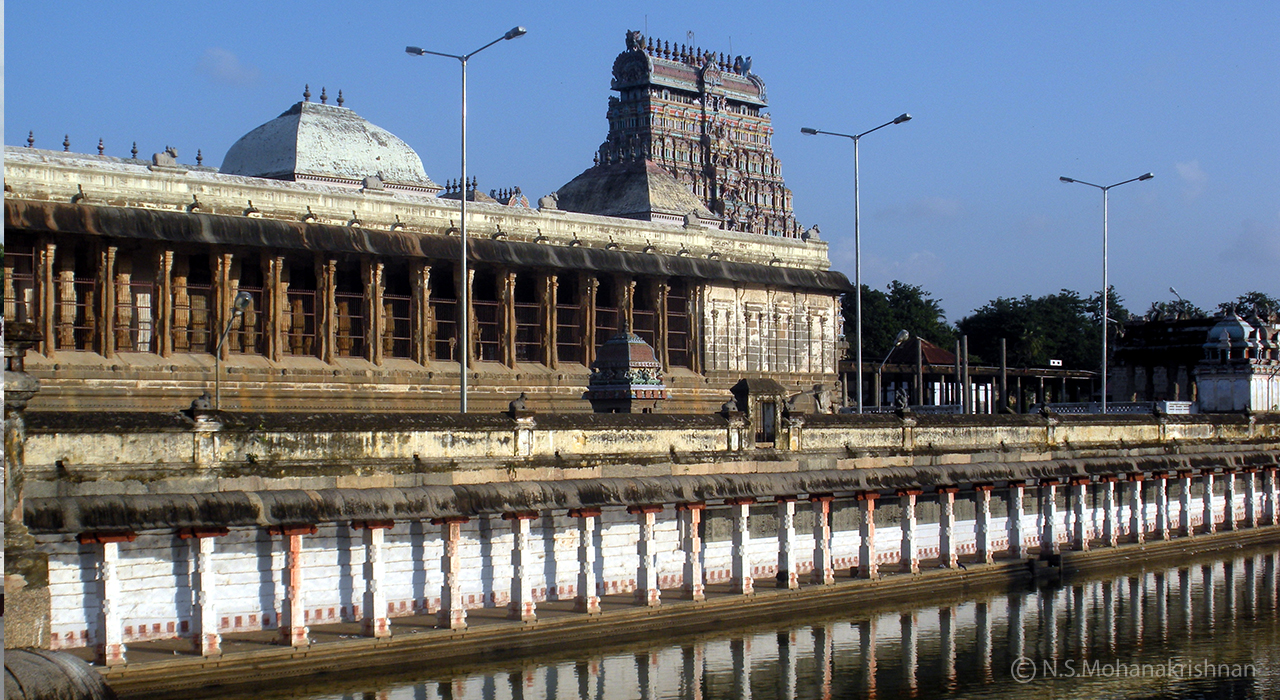
God
Goddess
Sivagamiamman, facing east
Other Deities
Vinayaga, Muruga, Viswanathar, Vaithyanathar, 63 Nayanmars, Saneeswarar, Navagrahas, Govindaraja Perumal (which is considered a separate 108 Divya Desam temple)
Kovil (Temple) meant only the Natarajar Chidambaram temple in the olden days. More than 1500 years old, the grandeure, size and the greatness of this temple has to be experienced to be believed. The Temple occupies more than 40 acres covering 4 Prakarams fortified with high walls. There are 9 gateways (which are said to represent the 9 openings in the human body) with Gopurams including the four main gateways in the four directions. These main Rajagopurams are all 7 tiered colossal structures portraying the artistic skills of the Tamil people. The eastern Gopuram has 108 dance postures from the Natya Shastra. The rest of them have depictions from hindu mythology, daily life and various other themes.
This is one of the 275 Paadal Petra Sivasthalams praised in the Thevaram hymns of the 3 great Saivite Saints Thirunavukkarasar, Thirugnanasambandar and Sundaramoorthy Nayanar. This is the temple where the ancient palm leaf manuscripts of the Hymns were kept until it was recovered and presented to the world under the rule of Rajaraja Chozha with the help of Nambiandar Nambi. This is one of the Pancha Bootha Sthalams (Five shrines representing the five elements of nature – Land, Water, Fire, Sky and Air which are believed to have been embodied in the Lingams) and this temple represents the Sky.The others are Kanchipuram Ekambaranadar Temple (Land), Thiruvanaikaval Temple (Water), Thiruvannamalai (Fire) and Srikalahasthi (Air) in Andhra Pradesh. This is also the only place where Lord Shiva is seen in all 3 forms – Roopam (with form) Aroopam (formless) and Rooparoopam (without the usual form). The main deity here is Lord Nataraja (Roopam) in the Sanctum Sanctorum. This same idol is also taken out as the processional idol unlike any other temple. Adjacent is the chamber where Shiva is present in the formless form of air (Aroopam). There is a Spatika Lingam and in a separate shrine is the Thirumoolanathar in Lingam form (Rooparoopam) which was the original main deity in the ancient days.
This temple is the Porchabhai (Golden Sabhai) – one of the 5 sites where Lord Shiva is believed to have performed his cosmic dance. The others are Vellichabhai (Silver): Madurai, Thamirasabhai (Copper): Thirunelveli, Chithirasabhai (Art): Kutralam, Rathinasabhai (Emerald): Thiruvalangadu.
There are Five Sabhais (Hall or Dais) inside here at Natarajar Chidambaram temple :
Chit Sabhai, Sanctum Sanctorum housing Lord Nataraja and his consort Goddess Sivagamasundari. This is covered with gold plates. To the left side of this is the chamber of secret (Chidambara Rahasyam).
Kanaka Sabhai – in front of the Chitsabhai, from which the daily rituals are conducted.
Nrithya Sabhai or Natya Sabhai, where the Lord is said to have danced with Goddess Kali – an embodiment energy and established his supremacy.
Raja Sabhai, the 1000-pillared hall
Deva Sabhai, which houses the Pancha moorthis (pancha – five, moorthis – deities, namely the deities of Ganesha, Somaskanda, Sivananda Nayaki, Muruga and Chandikeswara.
Adjacent to the Sanctum Sanctorum is the small space kept covered which is famously referred as the Chidambara Rahasyam (Secret of Chidambaram) – Chitrambalam. Actually there is nothing inside except for a hanging gold Vilwa leaf garland. The lord here represents the Pancha Bhootha element of Air, thus only air is in this chamber. There are several spiritual concepts and explanations to this.
The 4 saivite saints are said to have reached Natarajar Chidambaram temple from the cardinal four directions. Lord Shiva as Nataraja and Govindaraja Perumal can be seen and worshiped from the same spot. A dance festival called Natyanjali takes place here annually every February.
The golden roof of the Sanctum Sanctorum (Chit Sabhai) has 28 pillars representing the 28 Agamas of worshiping Shiva, the roof is held up by 64 beams representing the 64 art forms, the roof has 21600 gold plates representing the average number of breath cycles taken by a human being in a day. These plates are held in place by 72000 nails which represent the 72000 nerves of the human body. The sanctum is topped with 9 Kalasams representing 9 forms of energy.
It is said that the Swastik symbol of Adolf Hitler was taken from the North Gopuram of Natarajar Chidambaram temple in the year 1931. He was also said to have had a team of Germans proficient in reading Vedas and they used to recite it before he made important decisions. Gandhiji, when visiting Natarajar Chidambaram temple took a handful of earth and kissed it saying that this was the holy land where Nandanar (one of the 63 Nayanmars) walked (see in legend section below).
There are about 100 wonderful Frescoes created more than 1000 years ago in the 100 pillar Mantapa and the Nandi Mantapam. Out of these 16 of them in fading condition were taken up for restoration. Frescoes are painted with natural pigments. Famed Artist Mr.Padmavasan was engaged to carry out this challenging task. He spent more than a year in the temple and using natural pigments and material sourced from from different parts of the country and world he has restored them and created similar panels as required. The subjects of these paintings include incidents including the origin of Thillai (today’s Chidambaram), life of Manickavasagar and the other saivite saints and Shiva worship.
Holy water (Theertham) – Sivagangai, Paramananda Koobam, Vyagrapadha Theertham, Anantha Theertham, Nagacheri Kulam, Brahma Theertham, Siva Priyai Tank, Pulimedu Tank, Kuyya Theertham, Thiruparkadal
Sacred Tree (Sthala Vriksham) – Thillai (Exocoeria agallocha), Aal (Ficus benghalensis)
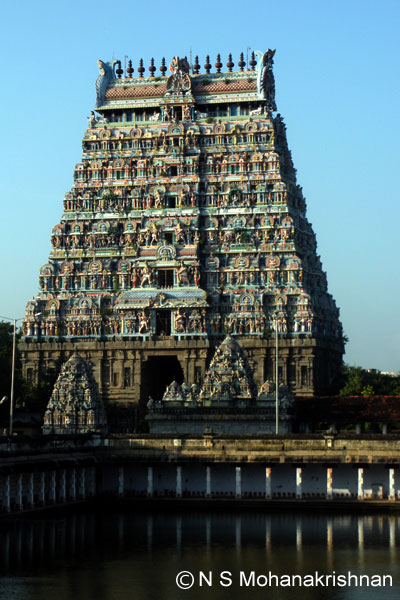
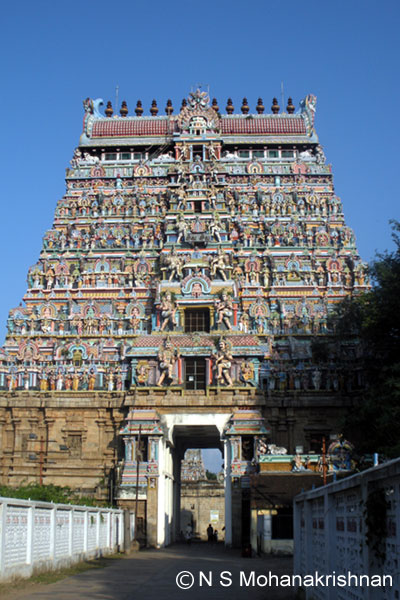
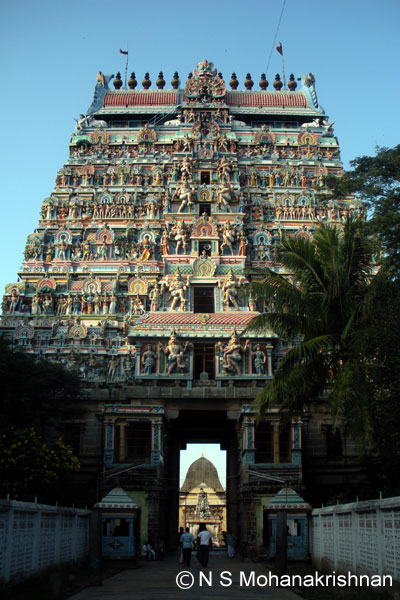
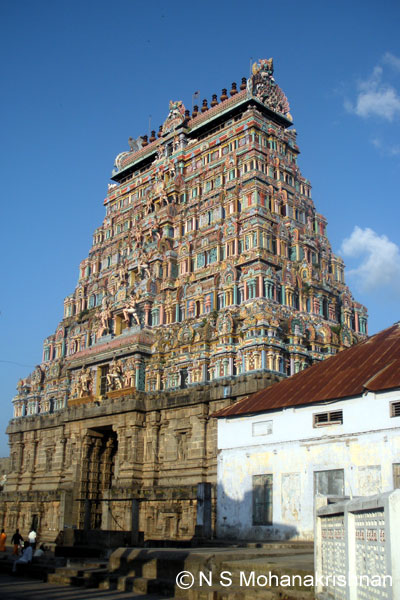
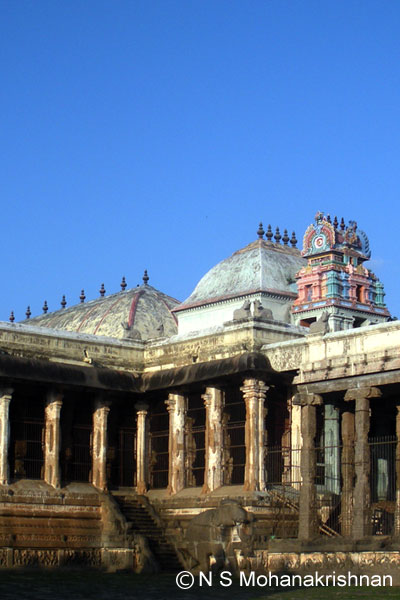
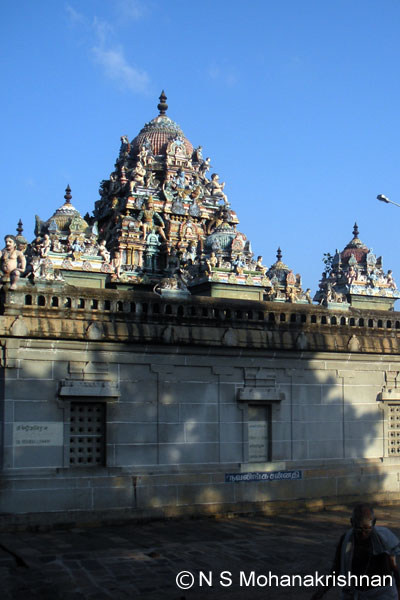
History
Records pertaining to the Sangam Period prior to 5th century CE mention the existence of a temple in this area though not as Chidambaram. Thirunavukkarasar, Thirugnanasambandar and Sundaramoorthy Nayanar who all lived between 7th and 8th century CE have sung the praise of the Lord here at Nataraja Chidambaram confirming the presence of the temple at that period. A chapter in the Skanda Purana also around the same period mentions the famous cosmic dance of Lord Shiva here at Nataraja Chidambaram. Chidambaram was the capital of the Chola Dynasty before it was shifted to Thanjavur by Raja Raja Chola. The earliest historically verifiable inscriptions date back to the rule of Aditya Chola I in the early 10th Century CE and during the rule of Parantaka Chola I (c.907-955 CE). Thus the present day temple is traceable to the early Chola Dynasty. The copper plate inscriptions of Parantaka Chola I describe him as the “bee at the lotus feet of Shiva” and calling him as the “Pon Veinda Perumal” – one who covered with gold the Chit-Sabha of the Nataraja Chidambaram temple.
Nataraja Chidambaram temple, according to inscriptions found in South India and Southeast Asia, received a precious jewel from the King of Angkor who built the Angkor Wat temple, through Kulothunga Chola, who submitted it to the temple in 1114 CE. In the 12th century CE Kulothunga I, his son, other Chola and Pandya Kings expanded the Nataraja Chidambaram temple including the 1000 Pillared Hall, Sacred Tank, the early Gopurams and Mantapas.
In the 13th Century CE the east and west gopurams were constructed by Sadayavarman Sundarapandian and the south gopuram by the Pallava King Kopperunchinga Devan. The north gopuram was constructed around 16th Century CE by Krishnadevaraya.
By the late 13th century Muslim invasions plundered and destroyed many parts of the temple. This came to an end with the rise of the Vijayanagar Empire and Nayak Kings and the temple along with so many other temples were restored to their former glory.
Legend
Manickavasagar after visiting many places and temples finally arrived at Nataraja Chidambaram temple and created many literary works including Thiruvasagam, Kandapaattu, Kulapathu, 3 Ahavals Kuil Paththu, Thirupuvali, Koil Pathigam and many more. A Budhist King, his dumb daughter accompanied by a Monk from Srilanka came to Chidambaram upon hearing about its greatness and challenged Saivism. The monk engaged in a debate with Manickavasagar whose prayers made the monk go dumb. Upon the request of the King he made his dumb daughter talk. He asked her various questions and her answers were compiled as ‘Thiruchazhal’. He then restored the voice of the Monk and all of them embraced Saivism. After this the Lord appeared as a Brahmin and wrote the Thiruvasagam himself as dictated by Manickavasagar. It was then kept on the Panchakshara steps after which the Lord vanished.
Rajaraja Chola was listening to some devotees singing a few hymns from Thevaram and desired to trace the entire set of hymns whose presence was not known. Knowing the greatness of Nambiandar Nambi of Thirunaaraiyur he approached him and through his devotion to the Polla Pillayar (Vinayaka) there he gleaned out the information of the presence of the palm leaf manuscripts in a room adjacent to the Ponnambalam in Nataraja Chidambaram temple. Nambiandar Nambi also told that the number of hymns were 16000 (Thirugnanasambandar), 49000 (Thirunavukkarasar) and 38000 (Sundarar)! The two of them went to Chidambaram convinced the Thillai Brahmins and opened the room to see the entire site covered in termite mounds. Whatever could be salvaged was codified by Nambiandar Nambi including the Thevaram and Thiruvasagam.
Nandanar, one of the 63 Nayanmars, reached Nataraja Chidambaram temple after delaying for years because of his low caste. The lord appeared in his dreams to prompt him to come and pass through a fire bath. Likewise he appeared in the dreams of the Thillai Brahmins and asked them to prepare the fire and receive Nandanar. Nandanar went through the fire entered the sanctum sanctorum and merged as one with the Lord.
Adisesha was born as Sage Pathanjali when he wished to see the dance of Lord Shiva and came here to Nataraja Chidambaram with Sage Vyagrapadha on the advise of Lord Vishnu.
There are many more such legendary events that have happened in Nataraja Chidambaram Temple.
Directions
Chidambaram is about 150 Kms south from Chennai. The Nataraja Chidambaram temple is visible from a long distance and the town is built around this temple. Lot of parking is available outside all entrances. You will require a good half day to explore this temple. Start early morning and finish before the heat of the day as the stone paved surroundings can get very hot to walk upon.
Stay and Food
There are many restaurants and hotels here including Udupi Krishna Bhavan in the western side of the temple.

